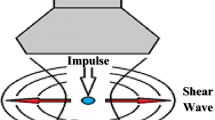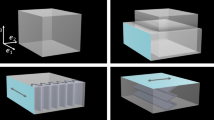Abstract
Objective
Magnetic resonance elastography (MRE) requires substantial data processing based on phase image reconstruction, wave enhancement, and inverse problem solving. The objective of this study is to propose a new, fast MRE method based on MR raw data processing, particularly adapted to applications requiring fast MRE measurement or high elastogram update rate.
Materials and methods
The proposed method allows measuring tissue elasticity directly from raw data without prior phase image reconstruction and without phase unwrapping. Experimental feasibility is assessed both in a gelatin phantom and in the liver of a porcine model in vivo. Elastograms are reconstructed with the raw MRE method and compared to those obtained using conventional MRE. In a third experiment, changes in elasticity are monitored in real-time in a gelatin phantom during its solidification by using both conventional MRE and raw MRE.
Results
The raw MRE method shows promising results by providing similar elasticity values to the ones obtained with conventional MRE methods while decreasing the number of processing steps and circumventing the delicate step of phase unwrapping. Limitations of the proposed method are the influence of the magnitude on the elastogram and the requirement for a minimum number of phase offsets.
Conclusion
This study demonstrates the feasibility of directly reconstructing elastograms from raw data.







Similar content being viewed by others
References
Asbach P, Klatt D, Schlosser B, Biermer M, Muche M, Rieger A, Loddenkemper C, Somasundaram R, Berg T, Hamm B, Braun J, Sack I (2010) Viscoelasticity-based staging of hepatic fibrosis with multifrequency MR elastography 1. radiology 257:80–86
Huwart L, Peeters F, Sinkus R, Annet L, Salameh N, ter Beek LC, Horsmans Y, Van Beers BE (2006) Liver fibrosis: non-invasive assessment with MR elastography. NMR Biomed 19:173–179
Garteiser P, Doblas S, Daire J-L, Wagner M, Leitao H, Vilgrain V, Sinkus R, Van Beers BE (2012) MR elastography of liver tumours: value of viscoelastic properties for tumour characterisation. Eur Radiol 22:2169–2177
Rouvière O, Yin M, Dresner MA, Rossman PJ, Burgart LJ, Fidler JL, Ehman RL (2006) MR elastography of the liver: preliminary results. Radiology 240:440–448
Sinkus R, Lorenzen J, Schrader D, Lorenzen M, Dargatz M, Holz D (2000) High-resolution tensor MR elastography for breast tumour detection. Phys Med Biol 45:1649
Murphy MC, Curran GL, Glaser KJ, Rossman PJ, Huston J, Poduslo JF, Jack CR, Felmlee JP, Ehman RL (2012) Magnetic resonance elastography of the brain in a mouse model of Alzheimer’s disease: initial results. Magn Reson Imaging 30:535–539
Schregel K, Wuerfel née Tysiak E, Garteiser P, Gemeinhardt I, Prozorovski T, Aktas O, Merz H, Petersen D, Wuerfel J, Sinkus R (2012) Demyelination reduces brain parenchymal stiffness quantified in vivo by magnetic resonance elastography. Proc Natl Acad Sci USA 109:6650–6655
Streitberger K-J, Sack I, Krefting D, Pfüller C, Braun J, Paul F, Wuerfel J (2012) Brain viscoelasticity alteration in chronic-progressive multiple sclerosis. PLoS One 7:e29888
Muthupillai R, Rossman PJ, Lomas DJ, Greenleaf JF, Riederer SJ, Ehman RL (1996) Magnetic resonance imaging of transverse acoustic strain waves. Magn Reson Med 36:266–274
Braun J, Guo J, Lützkendorf R, Stadler J, Papazoglou S, Hirsch S, Sack I, Bernarding J (2014) High-resolution mechanical imaging of the human brain by three-dimensional multifrequency magnetic resonance elastography at 7 T. NeuroImage 90:308–314
Klatt D, Hamhaber U, Asbach P, Braun J, Sack I (2007) Noninvasive assessment of the rheological behavior of human organs using multifrequency MR elastography: a study of brain and liver viscoelasticity. Phys Med Biol 52:7281–7294
Papazoglou S, Hirsch S, Braun J, Sack I (2012) Multifrequency inversion in magnetic resonance elastography. Phys Med Biol 57:2329–2346
Perrinez PR, Kennedy FE, Van Houten EEW, Weaver JB, Paulsen KD (2010) Magnetic resonance poroelastography: an algorithm for estimating the mechanical properties of fluid-saturated soft tissues. IEEE Trans Med Imaging 29:746–755
Vappou J, Breton E, Choquet P, Goetz C, Willinger R, Constantinesco A (2007) Magnetic resonance elastography compared with rotational rheometry for in vitro brain tissue viscoelasticity measurement. Magn Reson Mater Phy 20:273–278
Chen J, Woodrum DA, Glaser KJ, Murphy MC, Gorny K, Ehman R (2013) Assessment of in vivo laser ablation using MR elastography with an inertial driver. Magn Reson Med 72:59–67
Corbin N, Vappou J, Breton E, Boehler Q, Barbé L, Renaud P, de Mathelin M (2016) Interventional MR elastography for MRI-guided percutaneous procedures. Magn Reson Med 75:1110–1118
Mariani A, Kwiecinski W, Pernot M, Balvay D, Tanter M, Clement O, Cuenod CA, Zinzindohoue F (2014) Real time shear waves elastography monitoring of thermal ablation: in vivo evaluation in pig livers. J Surg Res 188:37–43
Corbin N, Vappou J, Rao P, Wach B, Barbé L, Renaud P, de Mathelin M, Breton E (2016) In vivo monitoring of percutaneous thermal ablation by simultaneous MR elastography and thermometry. In: Proceedings of the 24th scientific meeting, international society for magnetic resonance in medicine, Singapore, p 205
Rump J, Klatt D, Braun J, Warmuth C, Sack I (2007) Fractional encoding of harmonic motions in MR elastography. Magn Reson Med 57:388–395
Garteiser P, Sahebjavaher RS, Ter Beek LC, Salcudean S, Vilgrain V, Van Beers BE, Sinkus R (2013) Rapid acquisition of multifrequency, multislice and multidirectional MR elastography data with a fractionally encoded gradient echo sequence. NMR Biomed 26:1326–1335
Murphy MC, Glaser KJ, Manduca A, Felmlee JP, Huston J, Ehman RL (2010) Analysis of time reduction methods for magnetic resonance elastography of the brain. Magn Reson Imaging 28:1514–1524
Sack I, Beierbach B, Hamhaber U, Klatt D, Braun J (2008) Non-invasive measurement of brain viscoelasticity using magnetic resonance elastography. NMR Biomed 21:265–271
Colton D, Kress R (1998) Inverse acoustic and electromagnetic scattering theory. Springer Science & Business Media, New York
Riek JK, Tekalp AM, Smith WE (1993) Effect of Z-motion in the phase of the K-space MRI data and identification of periodic Z-motion kernels. In: Proceedings of the IEEE international conference on acoustics, speech, and signal processing, Minneapolis, pp 511–514
Knutsson H, Westin C-F, Granlund G (1994) Local multiscale frequency and bandwidth estimation. In: Proceedings of the IEEE international conference on image processing, Austin, pp 36–40
Manduca.A, Muthupillai R, Rossman PJ, Greenleaf JF, Ehman R(1996) Image analysis for magnetic resonance elastography. In: Proceedings of the IEEE international conference on engineering in medicine and biology society, Amsterdam, pp 756–757
Goldstein RM, Zebker HA, Werner CL (1988) Satellite radar interferometry: two-dimensional phase unwrapping. Radio Sci 23:713–720
Barnhill E, Kennedy P, Johnson CL, Mada M, Roberts N (2014) Real-time 4D phase unwrapping applied to magnetic resonance elastography. Magn Reson Med 73:2321–2331
Wang H, Weaver JB, Perreard II, Doyley MM, Paulsen KD (2011) A three-dimensional quality-guided phase unwrapping method for MR elastography. Phys Med Biol 56:3935–3952
Acknowledgements
This work was partly funded by the French state funds managed by the ANR (within the Investissements d’Avenir programme for the Labex CAMI); Grant Number: ANR-11-LABX-0004, and the IHU Strasbourg; Grant Number: ANR-10-IAHU-02.
Author information
Authors and Affiliations
Corresponding author
Ethics declarations
Conflict of interest
The authors declare no conflict of interest.
Research involving animals
All applicable international, national, and/or institutional guidelines for the care and use of animals were followed. In vivo experiments of this study were performed according a protocol approved by a local ethics committee (ICOMETH C2EA—38).
Informed consent
Not applicable to this study.
Appendix
Appendix
A temporal Fourier transform is applied on a set of k-space raw data acquired with varying delays between mechanical excitation and motion encoding gradients. By selecting only the temporal frequency of interest, most of the harmonics of the spatial frequency are removed.
The result is described by Eq. (12):
As described by the set U, the component of interest (n = 1) is not the only one component selected by the filtering because of aliasing. In most cases, the other components are negligible compared to the first one (blue signal in Fig. 8b), nevertheless the selection of other non–negligible components remains possible when the number of phase-offsets is poorly chosen as illustrated in Fig. 8c–d (red signal). It is therefore relevant to assess conditions that favor an optimal ratio between the amplitude of the 1st and the (kN t + 1)th, k ∊ Z * components of the spectrum that are susceptible to being associated to the same temporal frequency. The ratio \(R\) is deduced from the previous equation:
a Simulated 1D MR signal with heterogeneous magnitude and sinusoidal phase. b Plot of the temporal Fourier transform of the previous k-space performed from the data set simulating six varying delays between motion encoding gradients and mechanical excitation. c Plot of the temporal Fourier transform performed from the data set simulating 3 varying delays between motion encoding gradients and mechanical excitation. d Plot of the filtering at the temporal frequency of interest in blue for the case with six phase-offsets and in red for the case with three phase-offsets
Let us consider that a component is negligible compared to the first one when its amplitude is at least ten times inferior, i.e. when R > 1. The number of phase-offsets N t required to satisfy this condition is plotted in Fig. 9 with respect to the C 1 parameter. Under the assumption that R > 1, Eq. (12). simplifies to Eq. (14).
Rights and permissions
About this article
Cite this article
Corbin, N., Breton, E., de Mathelin, M. et al. K-space data processing for magnetic resonance elastography (MRE). Magn Reson Mater Phy 30, 203–213 (2017). https://doi.org/10.1007/s10334-016-0594-8
Received:
Revised:
Accepted:
Published:
Issue Date:
DOI: https://doi.org/10.1007/s10334-016-0594-8






